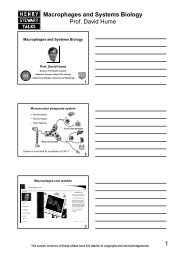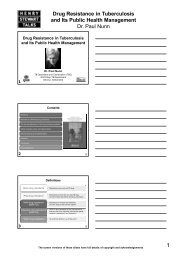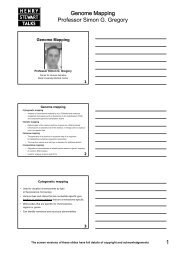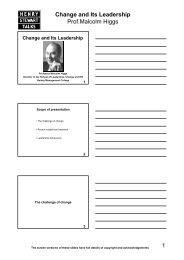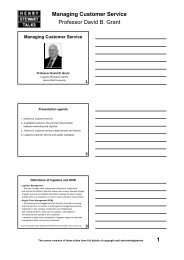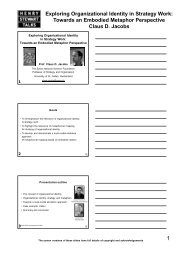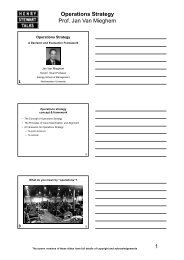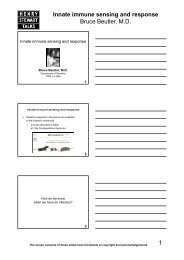Quantitative Financial Risk Management - Henry Stewart Talks
Quantitative Financial Risk Management - Henry Stewart Talks
Quantitative Financial Risk Management - Henry Stewart Talks
You also want an ePaper? Increase the reach of your titles
YUMPU automatically turns print PDFs into web optimized ePapers that Google loves.
<strong>Quantitative</strong> <strong>Financial</strong> <strong>Risk</strong> <strong>Management</strong><br />
Specially prepared, animated, audiovisual briefings by leading experts from industry and academia;<br />
available when you want, where you want and as often as you want.<br />
Available on individual user license for $2500 (£1515, €1775) and on site license for $4999 (£2999,<br />
€3550) giving unlimited access for all members of an organization within a single country.<br />
To purchase the series complete and return order form on page 6.<br />
I: INTRODUCTORY REVIEWS<br />
1. Practical use of portfolio risk management<br />
today<br />
Definitions of risk management (RM) in different contexts –<br />
Practical application rather than theory – Does RM make a<br />
major contribution to portfolio safety – Can RM exacerbate<br />
adverse markets – The impacts of regulatory risk on fund<br />
managers – Appropriate or mistargeted – How is risk forecast<br />
and how does that feed into the investment process – Do<br />
quantitative techniques add value or lower risk – <strong>Risk</strong><br />
strategies: how to measure, implement and control<br />
Mr. Daryl Roxburgh – Head, BITA <strong>Risk</strong> Solutions, UK and<br />
USA<br />
Daryl Roxburgh is Head of BITA <strong>Risk</strong> Solutions, the London and<br />
New York based portfolio construction and risk solutions<br />
provider. Daryl is a graduate of the City University (now John<br />
Cass) Business School and his career commenced as a private<br />
client fund manager with Buckmaster & Moore. He progressed<br />
to a senior management role in 1987 and was subsequently<br />
appointed Director of IT in 1994 for Credit Suisse Asset<br />
<strong>Management</strong>. Following two years at M&G, he was recruited by<br />
Prudential Portfolio Managers as Global Head of IT in 1998. He<br />
now specializes in portfolio construction and risk analysis<br />
solutions for the quantitative, institutional and private banking<br />
markets.<br />
2. Statistical models for risk management<br />
Definition of returns: simple returns and log returns –<br />
Distribution of returns, univariate: normal and log-normal<br />
distribution – Stylized facts of historical returns – Skewness,<br />
kurtosis, autocorrelation and stationarity – ARCH, GARCH and<br />
stochastic volatility (SV) models – Distribution of returns,<br />
multivariate: multivariate normal distribution – Multivariate<br />
GARCH and SV models – Copulas and non-linear dependence<br />
Prof. John Knight – Professor of Economics, University of<br />
Western Ontario, Canada<br />
John Knight received his PhD from the University of New South<br />
Wales, Australia in 1980. He has held teaching and research<br />
positions in the US, Australia, UK and Canada and has been in<br />
his current position since 1987. His extensive list of research<br />
publications are in theoretical econometrics and more recently<br />
in financial econometrics. In 2002 he was awarded a Plura<br />
Scripsit Award by the journal Econometric Theory. He has also<br />
won awards for his graduate teaching and PhD supervision.<br />
Current research interests include stochastic volatility modeling<br />
and the estimation of continuous time processes in finance.<br />
3. Utility theory and mean variance<br />
Expected utility representation of preferences – Rationality<br />
criteria – State independent utility – <strong>Risk</strong> averse behavior – <strong>Risk</strong><br />
and insurance premium – Arrow-Pratt’s absolute risk aversion<br />
coefficient – <strong>Risk</strong> aversion and small risk – Relative risk<br />
aversion coefficient – <strong>Risk</strong> tolerance – CARA utility – CRRA<br />
utility – <strong>Risk</strong> aversion and large risk – Utility and variance<br />
measures of risk – Variance aversion and two fund separation –<br />
Local risk neutrality – Marginal utility and two fund separation –<br />
Factor structure and two fund separation<br />
Dr. Norvald Instefjord – Reader in Finance, University of<br />
Essex, UK<br />
Norvald is a Reader in Finance and an Associate Director of<br />
Finance Studies at the Department of Accounting, Finance and<br />
<strong>Management</strong> at the University of Essex. He received a PhD in<br />
finance from the London Business School in 1995 and was a<br />
Lecturer in Finance at Birkbeck College, University of London,<br />
from 1994 to 2004. Norvald’s primary research interests are<br />
corporate finance (including disclosure and corporate<br />
governance issues), banking (including risk management and<br />
issues linked to fraud and operational risk), and security and<br />
market design. He also has extensive teaching experience in<br />
general and corporate finance, mathematical and theoretical<br />
finance and market microstructure.<br />
4. Definitions of risk<br />
Distributional properties of risk – Variance – <strong>Risk</strong> aversion and<br />
variance aversion – First order stochastic dominance – Second<br />
order stochastic dominance – Axiomatic approach to risk<br />
measures – <strong>Risk</strong> as a choice variable – Acceptable and nonacceptable<br />
risk – Single-dimensional risk measures – <strong>Risk</strong><br />
measure and risk capital – Coherent risk measures – Value-atrisk<br />
(VaR) is not coherent – TailVaR and worst conditional<br />
expectations – Rotschild/Stiglitz increasing risk – Conclusions:<br />
risk definition depends on context and purpose<br />
Dr. Norvald Instefjord – Reader in Finance, University of<br />
Essex, UK<br />
Norvald is a Reader in Finance and an Associate Director of<br />
Finance Studies at the Department of Accounting, Finance and<br />
<strong>Management</strong> at the University of Essex. He received a PhD in<br />
finance from the London Business School in 1995 and was a<br />
Lecturer in Finance at Birkbeck College, University of London,<br />
from 1994 to 2004. Norvald’s primary research interests are<br />
corporate finance (including disclosure and corporate<br />
governance issues), banking (including risk management and<br />
issues linked to fraud and operational risk), and security and<br />
market design. He also has extensive teaching experience in<br />
general and corporate finance, mathematical and theoretical<br />
finance and market microstructure.




